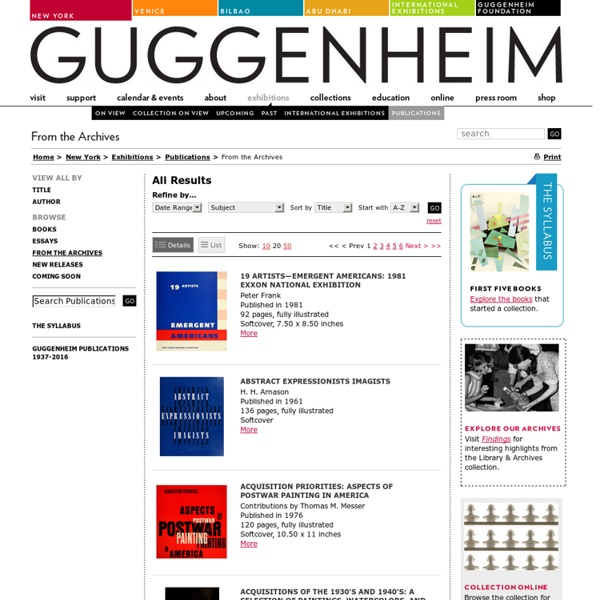



From the Archives China: 5,000 Years, Innovation and Transformation in the Arts Contributions by Helmut Brinker, James Cahill, Elizabeth Childs-Johnson, Patricia Ebrey, Sherman Lee, and Zhang Wenbin Published in 1998 504 pages, fully illustrated English and Spanish editions The exhibition China: 5,000 Years, Innovation and Transformation in the Arts opened at the Solomon R. Guggenheim Museum in early 1998 and traveled to the Guggenheim Museum Bilbao in the same year. It was one of the first exhibitions held in the newly opened Guggenheim Museum Bilbao, and marks the Guggenheim Foundation's dedication to the study and exhibition of Asian art. The catalogue accompanying the exhibition is an invaluable resource for scholars of Chinese culture and art. Excerpt The reader will by now be aware that this is an exhibition which stresses the art of an ancient culture with particular relation to innovation and creativity. Related Exhibitions China: 5,000 Years Related Books Related Essays
Guggenheim Collection Online Featuring nearly 1600 artworks by more than 575 artists, the Collection Online presents a searchable database of selected artworks from the Guggenheim’s permanent collection of over 7,000 artworks. The selected works reflect the breadth, diversity, and tenor of the Solomon R. Guggenheim Foundation’s extensive holdings from the late 19th century through the present day, and are continually expanded to include a larger representation of the museum’s core holdings as well as recent acquisitions. In addition to highlights from the Solomon R. Learn More about the Collection
14 Punctuation Marks That You Never Knew Existed Watch Free Documentaries Online Ebooks Living with food restrictions? You can still have delicious, varied meals that anyone would be happy to share! Enjoy breakfasts, desserts, or holiday meals, all without sugar, gluten, eggs or dairy! And for anyone who’s gone from anti-candida to healthy maintenance, Sweet Freedom offers desserts without wheat, eggs, dairy or refined sugars (some spelt and barley flour as well as natural sweeteners). To read more about each digital cookbook, click on the title below. 5 Ebook Bundle: Get my top 5 ebooks for 30% off! Holiday Desserts without Sugar, Gluten, Eggs or Dairy cookbook Sweet Favorites, Candida-Free cookbook Living Candida-Free Sampler cookbook Top 12: Favorite Candida Diet Stage 1 Recipes cookbook Good Morning! A Sweet Life Thanksgiving cookbook [available from September until US Thanksgiving only] Sweet Freedom cookbook (not suitable for an anti-candida diet)
Search Engines:Digital Libraries From Topical Search Wiki General Resources digital libraries Aggregators The Digital Public Library of America (DPLA) – A front end interface to US and international digital archives that intendend to make them accessible to the general public. National Aggregators Europeana – A multilingual catalog of books, paintings, films, museum objects and archival records from more than 2,000 institutions across Europe. Online Books Project GutenbergTopHQBooks.com – PDF books search EBOOKEE – A catalog of downloadable ebooks from "one-click hosting" services like 4shared, Mediafire, and Rapidshare. Audio Books Visual Resourses Academic Resources Open Access Journals Main Page Search Engines:Open Access Image Search CC Search – A polysearch engine for Creative Commons (CC) and other open licensed content. Open Access Publications Open acceess repositories OpenAIRE – An aggregator and repository of European OA research. Open Educational Resources (OER) Academic OERs Main Page Search Engines:Open Access/OER
Visualising China: explore historical photos of China World Digital Library Home DIY Geometric Necklace Pendant Happy New Year! I hope everyone had a wonderful time celebrating. I actually made it until midnight...I was pretty proud of myself :) 2012 is going to be amazing...I just know it! I want to kick off the new year with a fun DIY that I have been wearing recently. What you will need:3 different colors of polymer claySome kind of roller (a large marker will also do the trick)Razor bladeCotton cordKrazy glueToothpick or object to poke a hole in clay Soften and condition the clay with your hands before starting. Carefully slice out 3 triangles. Poke a hole in the smallest of the 3 triangles. Krazy glue the triangles on top of each other, staggering them a little bit. Attach the necklace cord and have fun wearing!
A publishing how-to: Tips from Stacey Pierson, Ph.D. (Part 1) « Post Academic Stacey Pierson is Lecturer (which translates to Assistant Professor here in the States) at the School of Oriental and African Studies (SOAS), University of London, specializing in Chinese Ceramics and Museum Studies. She is also the one-time curator of the prestigious Percival David Foundation of Chinese Art, and I imagine she could also probably work as a junior archeologist, ace appraiser, and Chinese translator, if she wanted to! "Chinese Ceramics book cover" (Courtesy of Stacey Pierson) But, for our purposes here at Post Academic, it’s her experiences as a published author of two books–Chinese Ceramics: A Design History (V&A, 2009) and Collectors, Collections and Museums: the Field of Chinese Ceramics in Britain, 1560-1960 (Peter Lang, 2007)–and her current post as the Editor of the journal Transactions of the Oriental Ceramics Society that we’re most interested in. Over the next few days, Dr. The interview continues below the fold… PA: What are the hardest parts of writing a book?
Seleccion de catálogos para vista online. by mariasimo Feb 2